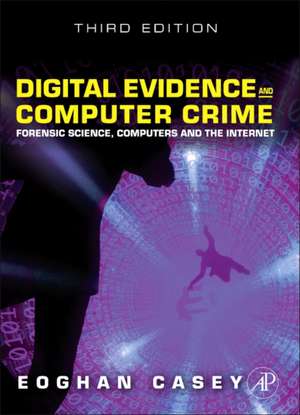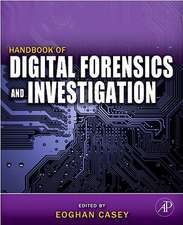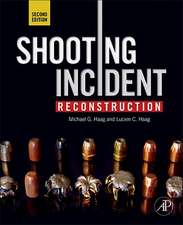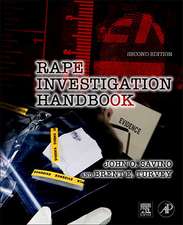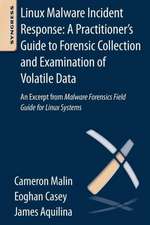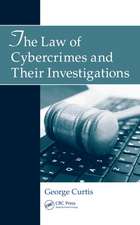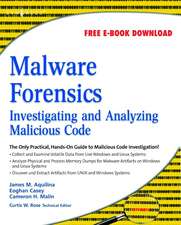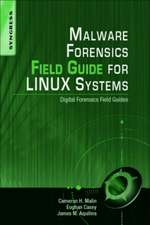Digital Evidence and Computer Crime: Forensic Science, Computers, and the Internet
Autor Eoghan Caseyen Limba Engleză Hardback – 17 iun 2011
It offers a thorough explanation of how computer networks function, how they can be involved in crimes, and how they can be used as a source of evidence. In particular, it addresses the abuse of computer networks as well as privacy and security issues on computer networks.
This updated edition is organized into five parts. Part 1 is about digital forensics and covers topics ranging from the use of digital evidence in the courtroom to cybercrime law. Part 2 explores topics such as how digital investigations are conducted, handling a digital crime scene, and investigative reconstruction with digital evidence. Part 3 deals with apprehending offenders, whereas Part 4 focuses on the use of computers in digital investigation. The book concludes with Part 5, which includes the application of forensic science to networks.
New to this edition are updated information on dedicated to networked Windows, Unix, and Macintosh computers, as well as Personal Digital Assistants; coverage of developments in related technology and tools; updated language for search warrant and coverage of legal developments in the US impacting computer forensics; and discussion of legislation from other countries to provide international scope. There are detailed case examples that demonstrate key concepts and give students a practical/applied understanding of the topics, along with ancillary materials that include an Instructor's Manual and PowerPoint slides.
This book will prove valuable to computer forensic students and professionals, lawyers, law enforcement, and government agencies (IRS, FBI, CIA, CCIPS, etc.).
- Named The 2011 Best Digital Forensics Book by InfoSec Reviews
- Provides a thorough explanation of how computers & networks function, how they can be involved in crimes, and how they can be used as evidence
- Features coverage of the abuse of computer networks and privacy and security issues on computer networks
Preț: 358.45 lei
Preț vechi: 471.99 lei
-24% Nou
Puncte Express: 538
Preț estimativ în valută:
68.60€ • 71.35$ • 56.63£
68.60€ • 71.35$ • 56.63£
Carte tipărită la comandă
Livrare economică 08-22 aprilie
Livrare express 08-14 martie pentru 105.06 lei
Preluare comenzi: 021 569.72.76
Specificații
ISBN-13: 9780123742681
ISBN-10: 0123742684
Pagini: 840
Ilustrații: Illustrations
Dimensiuni: 191 x 235 x 46 mm
Greutate: 1.88 kg
Ediția:3. Auflage.
Editura: Elsevier
ISBN-10: 0123742684
Pagini: 840
Ilustrații: Illustrations
Dimensiuni: 191 x 235 x 46 mm
Greutate: 1.88 kg
Ediția:3. Auflage.
Editura: Elsevier
Public țintă
Computer forensic students and professionals, lawyers, law enforcement, government agencies (IRS, FBI, CIA, CCIPS, etc.).Cuprins
PART 1: Digital Forensics
1. Foundations of Digital Forensics
2. Language of Computer Crime Investigation
3. Digital Evidence in the Courtroom
4. Cybercrime Law: A United States Perspective
5. Cybercrime Law: European Perspective
PART 2: Digital Investigations
6. Conducting Digital Investigations
7. Handling a Digital Crime Scene
8. Investigative Reconstruction with Digital Evidence
9. Modus Operandi, Motive, and Technology
PART 3: Apprehending Offenders
10. Violent Crime and Digital Evidence
11. Digital Evidence as Alibi
12. Sex Offenders on the Internet
13. Investigating Computer Intrusions
14. Cyberstalking
PART 4: Computers
15. Computer Basics for Digital Investigators
16. Applying Forensic Science to Computers
17. Forensic Examination of Windows Systems
18. Forensic Examination of UNIX Systems
19. Forensic Examination of Macintosh Systems
20. Forensic Examination of Mobile Devices (online only)
PART 5: Network Forensics
21. Network Basics for Digital Investigators
22. Applying Forensic Science to Networks
23. Digital Evidence on the Internet
24. Digital Evidence on Physical and Data-Link Layers
25. Digital Evidence at the Network and Transport Layers
1. Foundations of Digital Forensics
2. Language of Computer Crime Investigation
3. Digital Evidence in the Courtroom
4. Cybercrime Law: A United States Perspective
5. Cybercrime Law: European Perspective
PART 2: Digital Investigations
6. Conducting Digital Investigations
7. Handling a Digital Crime Scene
8. Investigative Reconstruction with Digital Evidence
9. Modus Operandi, Motive, and Technology
PART 3: Apprehending Offenders
10. Violent Crime and Digital Evidence
11. Digital Evidence as Alibi
12. Sex Offenders on the Internet
13. Investigating Computer Intrusions
14. Cyberstalking
PART 4: Computers
15. Computer Basics for Digital Investigators
16. Applying Forensic Science to Computers
17. Forensic Examination of Windows Systems
18. Forensic Examination of UNIX Systems
19. Forensic Examination of Macintosh Systems
20. Forensic Examination of Mobile Devices (online only)
PART 5: Network Forensics
21. Network Basics for Digital Investigators
22. Applying Forensic Science to Networks
23. Digital Evidence on the Internet
24. Digital Evidence on Physical and Data-Link Layers
25. Digital Evidence at the Network and Transport Layers
Recenzii
"Throughout the book there are a number of good case studies used to illustrate points which enlivens the text. There are also details of legal cases from various legislative areas and examples of relevant situations that demonstrate the points being made. There are also a number of references to other literature and links to website URLs and tools available to assist the practitioner." --Best Digital Forensics Book in InfoSecReviews Book Awards
"Just finished ‘Digital Evidence and Computer Crime: Forensic Science, Computers and the Internet’ by Eoghan Casey and featuring other contributing authors, and it’s quite good. I bought this book because I wanted an all-encompassing book that provided insight on the various aspects of an investigation, especially the legal portion. And in this aspect the book does an excellent job, and is in-depth in area’s I have yet to see in other books. The book is divided into five portions digital forensics, digital investigations, apprehending offenders, computers and network forensics. For me the book was worth it for the first three portions; however, the computers and network portions, while a good start, there are more in-depth books that provide better insight… Overall, the book was enjoyable from start to finish and I would recommend it to anyone looking for a great overview of digital forensic investigation process from start to finish. I am happy to add this book to my growing reference library." --Student of Security
"This hefty book on forensic evidence obtained from computers dispels the myths propagated by popular television series. It states from the premise that very few people are well versed in the technical, evidential, and legal issues concerning digital evidence. Oftentimes, the useful evidence that may be found in various digital media is overlooked, collected incorrectly, or analyzed ineffectively. It is the goal of the team of contributors to equip readers with the necessary knowledge and skills to be able to make use of digital evidence correctly and effectively…. It is quite obvious that the various authors draw from several fields, such as forensic science, computer science, political science, criminal justice, the law, and behavioral analysis; as such, it is multi- and interdisciplinary. More specifically, the authors tackle the specific crimes of cyber bullying, cyber stalking, identity theft, online sex offenders, fraudsters, and cyber threats. There is extensive use of boxed stories, legal cases, practitioner’s tips, tables, the discussion of legislation, flow charts, treaties and journals, as well as figures, diagrams, pictures, and computer screen shots. The book is comparative in nature: it covers not only cyber law in the US, but also case law in the UK, Ireland, and the Netherlands. Given the ubiquity of the computer and the crimes that it can generate, learning about how other nations handle these issues helps in the formation of our own methods for dealing with crimes domestically, as well as those that cross national boundaries." --ACM’s Computing Reviews.com
"A better title for Digital Evidence and Computer Crime might be the Comprehensive Guide to Everything You Need to Know About Digital Forensics. One is hard pressed to find another book overflowing with so many valuable details and real-world examples." --Ben Rothke on Slashdot.org (Sept 2011)
"Just finished ‘Digital Evidence and Computer Crime: Forensic Science, Computers and the Internet’ by Eoghan Casey and featuring other contributing authors, and it’s quite good. I bought this book because I wanted an all-encompassing book that provided insight on the various aspects of an investigation, especially the legal portion. And in this aspect the book does an excellent job, and is in-depth in area’s I have yet to see in other books. The book is divided into five portions digital forensics, digital investigations, apprehending offenders, computers and network forensics. For me the book was worth it for the first three portions; however, the computers and network portions, while a good start, there are more in-depth books that provide better insight… Overall, the book was enjoyable from start to finish and I would recommend it to anyone looking for a great overview of digital forensic investigation process from start to finish. I am happy to add this book to my growing reference library." --Student of Security
"This hefty book on forensic evidence obtained from computers dispels the myths propagated by popular television series. It states from the premise that very few people are well versed in the technical, evidential, and legal issues concerning digital evidence. Oftentimes, the useful evidence that may be found in various digital media is overlooked, collected incorrectly, or analyzed ineffectively. It is the goal of the team of contributors to equip readers with the necessary knowledge and skills to be able to make use of digital evidence correctly and effectively…. It is quite obvious that the various authors draw from several fields, such as forensic science, computer science, political science, criminal justice, the law, and behavioral analysis; as such, it is multi- and interdisciplinary. More specifically, the authors tackle the specific crimes of cyber bullying, cyber stalking, identity theft, online sex offenders, fraudsters, and cyber threats. There is extensive use of boxed stories, legal cases, practitioner’s tips, tables, the discussion of legislation, flow charts, treaties and journals, as well as figures, diagrams, pictures, and computer screen shots. The book is comparative in nature: it covers not only cyber law in the US, but also case law in the UK, Ireland, and the Netherlands. Given the ubiquity of the computer and the crimes that it can generate, learning about how other nations handle these issues helps in the formation of our own methods for dealing with crimes domestically, as well as those that cross national boundaries." --ACM’s Computing Reviews.com
"A better title for Digital Evidence and Computer Crime might be the Comprehensive Guide to Everything You Need to Know About Digital Forensics. One is hard pressed to find another book overflowing with so many valuable details and real-world examples." --Ben Rothke on Slashdot.org (Sept 2011)
